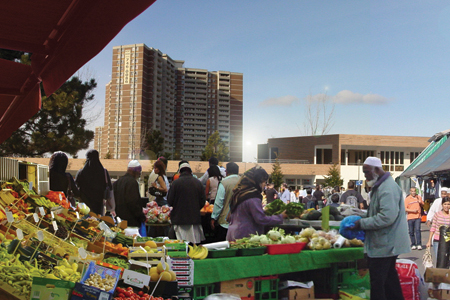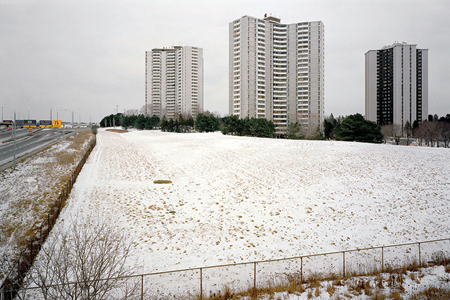Introduction
The neighbourhoods that ring Toronto’s central core include more than 1000 tall apartment buildings. It’s the largest concentration of high rise apartments in North America.
Most of the towers were built in the 1960s and 1970s for people who had few children, would someday move to houses, and would be able to drive to the places they needed to go. Today a different population is living in these tall apartments – often newcomers with limited incomes, people with children and complicated travel needs, and people who do not own a car.
The tower neighbourhoods feature tall buildings surrounded by a sea of open space. That open space is often pleasant, but there’s usually no place nearby to shop, or go to school or even to sit. Walking is tough.
And so an ambitious Toronto project for Tower Neighbourhood Renewal has begun. The project follows the principles described by Jane Jacobs.
Zoning revisions plus tax arrangements and loan guarantees at no net cost to the city will encourage landlords to retrofit the insides and outsides of their buildings with green systems that will repay the original investments. The zoning revisions will also allow commercial and institutional uses to grow between and within the towers, which in turn will encourage neighbourhood social life.
This will benefit the tower residents, the owners of the buildings, and everybody in the surrounding neighbourhoods.
Quick Facts About Tower Neighbourhood Renewal
- The goals of Tower Neighbourhood Renewal: Improve environmental performance through upgraded exterior cladding, solar water heating and more; engender vibrant social/cultural development; and enhance the health of the economy and labour-market both of local communities and Toronto as a whole. These goals are intertwined and give each other mutual support.
- Many Apartment Tower Neighbourhoods lack access to daily conveniences within walking distance. This presents a challenging commute on foot or by transit, and leaves large residential areas devoid of activity.
- A full 62% of rental Apartment Towers are zoned exclusively for residential purposes. An additional 17% allow a small commercial unit, often a small tuck shop or convenience store.
- Less than 1% of Apartment Towers are zoned ‘mixed development’ that would allow diverse and extensive retail shops and services.
- As a result, Apartment Tower Neighbourhoods often lack convenient access to the services and amenities that offer employment opportunities and address community needs.
Tower Neighbourhood Renewal Ideas
- New Facilities: David Hulchanski at the University of Toronto, believes the city should work with private landlords to renew the clusters of aging and energy inefficient high-rises that are owned by both Toronto Community Housing and the private sector. “You use the open (green) space to add shopping, places for small businesses and more housing. The new development generates money to do interesting things, in terms of further renovating the buildings.”
- Programming for Tenants: With 164,000 residents living in Toronto Community Housing units, programming is a prime concern. Social activity programs like exercise and cooking classes promote the physical and mental health of and connect them to their community, says Cyril Borgai of the Black Creek Community Health Centre.
- Energy Retrofits: Glenn Miller at the Canadian Urban Institute says, “One approach to addressing the capital repair backlog is oriented to the energy retrofits that would reduce the upgrading costs. There are quite a few companies that are expert in the retrofit business – and here we’re talking apartment blocks, rather than small units – where the retrofits are paid for through future energy savings.”
The Benefits of Tower Neighbourhood
Tower Renewal is about more tan energy efficiency. There are a broad range of benefits associated with the program including:
- Stronger communities through local job creation, enhanced availability of local food and services, improved open space and outdoor recreational space, and the inclusion of tenants in the planning and implementation of projects.
- Increased social and cultural benefits through a focus on community heritage and improvements to the built and natural environments in neighbourhoods.
- Enhanced local economic activity through on-site retail and services, commercialiation of green technology, and new employment and business opportunities.
Case Study: San Romanoway Revitalization a Success
- Business case for private sector investment in community development
- San Romanoway (Jane-Finch): three towers – 892 units, 4,400 residents
- Had high vacancy rates, vandalism, crime, bad reputation
- Now buildings full to capacity with waiting list
- Drop in vandalism, property damage, violent crime
- Revitalization: physical improvements, social programs, service provision
- Community & government contributions, corporate partnerships
- Residents empowered to improve their lives, community
- Increased resident satisfaction
Weston/Mt. Dennis Apartment Neighbourhood Renewal
- Goal: sustainable, vibrant neighbourhood
- 30-building apartment cluster
- Limited transit access, lack of cohesion, 1/4 low income, newcomers
- City Council directive: assess opportunity for Tower Renewal
- More opportunity for improvement than with single building
- District energy, community gardens, buying consortiums, improved waste diversion targets, supporting transit use, creating a market for new development


